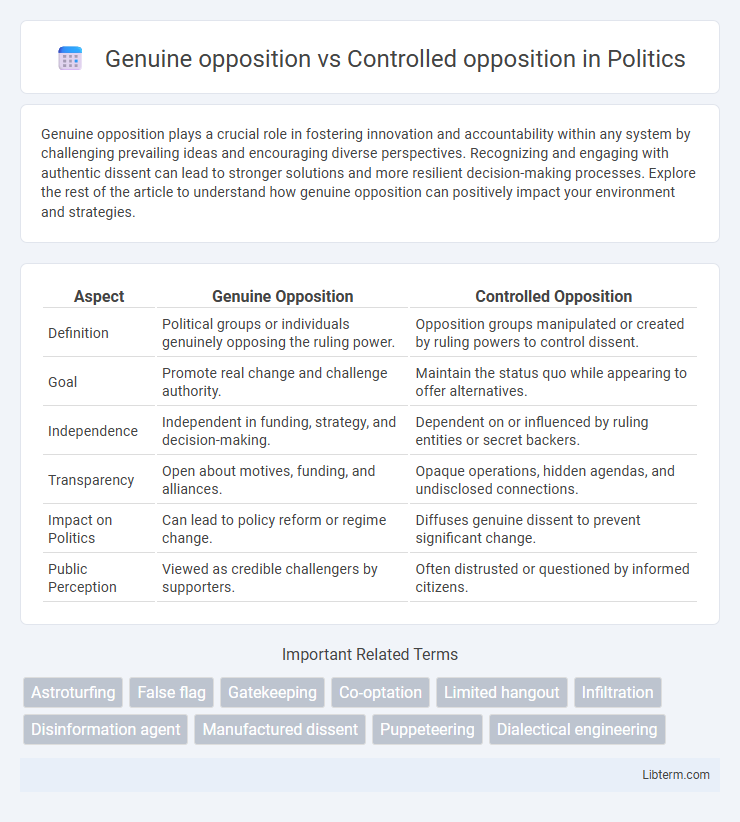Genuine opposition plays a crucial role in fostering innovation and accountability within any system by challenging prevailing ideas and encouraging diverse perspectives. Recognizing and engaging with authentic dissent can lead to stronger solutions and more resilient decision-making processes. Explore the rest of the article to understand how genuine opposition can positively impact your environment and strategies.
Table of Comparison
| Aspect | Genuine Opposition | Controlled Opposition |
|---|---|---|
| Definition | Political groups or individuals genuinely opposing the ruling power. | Opposition groups manipulated or created by ruling powers to control dissent. |
| Goal | Promote real change and challenge authority. | Maintain the status quo while appearing to offer alternatives. |
| Independence | Independent in funding, strategy, and decision-making. | Dependent on or influenced by ruling entities or secret backers. |
| Transparency | Open about motives, funding, and alliances. | Opaque operations, hidden agendas, and undisclosed connections. |
| Impact on Politics | Can lead to policy reform or regime change. | Diffuses genuine dissent to prevent significant change. |
| Public Perception | Viewed as credible challengers by supporters. | Often distrusted or questioned by informed citizens. |
Defining Genuine Opposition
Genuine opposition represents authentic political or social groups that challenge ruling powers with real intentions for change, often facing significant risks. These entities operate independently, with transparent goals and grassroots support reflecting public interests. In contrast to controlled opposition, genuine opposition maintains ideological integrity and resists manipulation by dominant authorities.
What is Controlled Opposition?
Controlled opposition refers to a group or individual that appears to challenge a dominant power or prevailing narrative but is secretly manipulated or influenced by that same power to mislead, divide, or neutralize genuine dissent. This tactic is often used in political, social, or activist contexts to undermine authentic movements by creating confusion or false alternatives. Detecting controlled opposition involves analyzing funding sources, affiliations, and inconsistencies in messaging that contrast with true opposing forces.
Key Differences Between Genuine and Controlled Opposition
Genuine opposition represents authentic resistance driven by independent goals and grassroots support, while controlled opposition is manipulated by dominant powers to create the illusion of dissent and undermine true challenges. Key differences include autonomy of leadership, transparency of motives, and the ability to mobilize genuine public engagement versus the use of disinformation and strategic concessions. Genuine opposition fosters organic change, whereas controlled opposition functions as a tool for maintaining the status quo under the guise of opposition.
Historical Examples of Genuine Opposition
Historical examples of genuine opposition include the Civil Rights Movement in the United States, where activists like Martin Luther King Jr. challenged systemic racism and segregation through nonviolent protest and legal reform. The Solidarity movement in Poland during the 1980s exemplified genuine opposition by uniting workers and intellectuals against communist authoritarian rule, ultimately contributing to political change. Similarly, the Indian independence movement led by figures such as Mahatma Gandhi successfully opposed British colonial rule through persistent civil disobedience and grassroots mobilization.
Notable Cases of Controlled Opposition
Notable cases of controlled opposition include historical examples such as the Soviet Union's use of dissident figures like Aleksandr Solzhenitsyn, who was monitored and subtly influenced by the KGB to control dissenting narratives. Another instance is the FBI's COINTELPRO operation targeting civil rights leaders like Martin Luther King Jr., where infiltration and manipulation stifled genuine opposition movements. These examples highlight how state actors employ controlled opposition to undermine authentic resistance and maintain political dominance.
Tactics Used by Controlled Opposition
Controlled opposition employs tactics such as infiltration, misinformation, and co-optation to undermine genuine dissent. By posing as legitimate activists, they manipulate public perception and dilute authentic movements. This strategy often includes spreading false narratives and redirecting energy away from core issues to maintain the status quo.
Signs of Authentic Political Resistance
Genuine opposition demonstrates consistent criticism of the ruling power, transparent motives, and grassroots support reflecting authentic political resistance. Controlled opposition often exhibits erratic dissent confined to safe, non-threatening topics, with leadership linked to the establishment to undermine real movements. Key signs of authentic resistance include independent funding sources, accountability to supporters, and a track record of challenging systemic injustices effectively.
The Impact of Controlled Opposition on Public Perception
Controlled opposition manipulates public perception by creating the illusion of dissent while steering discourse towards predetermined agendas, undermining genuine activism. This strategy erodes trust in authentic movements, leading to confusion and skepticism among the public. Consequently, controlled opposition hampers social progress by diluting the clarity and effectiveness of legitimate opposition efforts.
How to Identify Controlled Opposition
Controlled opposition can be identified by analyzing inconsistencies between their stated goals and actions, often revealing covert alignment with the dominant power. Indicators include repeated neutralization of impactful dissent, infiltration by known agents, and the promotion of divisions within genuine movements to weaken their effectiveness. Monitoring patterns of misinformation, funding sources, and reluctance to challenge core system structures helps distinguish controlled opposition from legitimate activism.
The Importance of Supporting Genuine Movements
Supporting genuine opposition is crucial for fostering authentic social and political change that reflects the true interests of the people. Controlled opposition, often orchestrated by existing power structures, undermines grassroots movements by diverting energy and trust away from legitimate efforts. Recognizing and backing genuine movements strengthens democratic processes and helps prevent manipulation by entities aiming to maintain the status quo.
Genuine opposition Infographic

 libterm.com
libterm.com